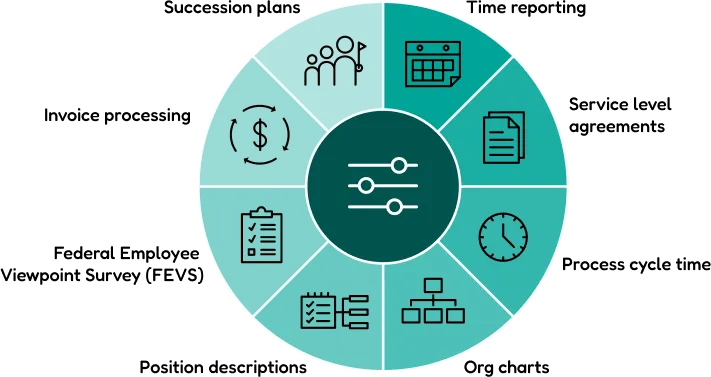Article
Operational efficiency metrics: The secret to doing more with less in government

Table of contents
Related services and insights
Organizational performanceHow to improve operational efficiency at government agencies: 5 strategies
With resource limitations and rising expectations, government agencies will have to get creative on how to get work done more efficiently. Luckily, it may take fewer resources than agency leaders imagine.
In our experience working with government agencies to leverage their business intelligence to make strategic performance improvements, we see one valuable resource often overlooked: the data they collect every day. The operational efficiency metrics contained within this data is key to making smarter, more strategic workforce decisions that boost capacity and improve efficiency.
By focusing on these meaningful metrics, agencies can uncover opportunities to redistribute workloads, streamline processes, and invest in areas that will drive long-term efficiency. Building capacity doesn’t always require new funding or staff—it starts with using existing data to optimize how work is accomplished.
Readily available operational efficiency metrics

Let’s examine a few in more detail:
1
Time reporting
Time reporting data provides clarity into where, how, and when people are working. While this is all valuable information already, its true potential is being left untouched. Taken a step further, time reporting data analysis can provide insight into time spent on tasks relative to their value, areas that burn budget faster than they should, and which employees perform the lion’s share of necessary work.
Performing contextual analysis could move time reporting beyond a simple agency requirement to answer questions that really matter, such as:
- Did the task further the mission?
- Does the task’s importance justify the time spent on it?
- Could the time have been spent more beneficially?
- Did the task further a personal or career goal?
- What concrete benefits did the task yield for the agency?
This is crucial information for both the team and the organization as a whole. With these insights, agencies can identify low-value activities that drain resources and uncover opportunities to optimize how time is spent. By shifting efforts to higher-impact tasks and addressing inefficiencies, agencies can improve operational efficiency and create the capacity needed to meet growing demands.
2
Service level agreements (SLAs)
SLAs are another readily available operational efficiency metric that agencies are likely collecting data around. By assessing their SLA performance data, agencies can identify areas where they might be overcommitting resources or misallocating effort. Consider these questions:
- Are we overservicing our customers—doing things for them they should be doing themselves?
- Do we have the right people with the right skills in the right areas?
- Do we need to spend more time training our employees?
3
Invoice processing
Another important factor to consider: invoice processing data. If it takes days to process an invoice, analyzing all the touch points along the way could highlight a range of issues needing improvement.
One example of a common issue includes time employees spend correcting errors that were made before the invoice was submitted. In this case, analyzing one metric with new context could cut cycle time, improving not just the volume of invoices flowing through the process, but also the experience of each employee, who benefits from exposing and removing the frustrating bottlenecks in their job.
Efficiency is a critical aspect of mission success, and its measurement is essential for identifying areas for improvement. By understanding operational efficiency metrics and tapping into this data, agencies can enhance efficiency and unlock capacity gains to achieve more with existing resources. A little upfront investment in new types of data analysis can provide remarkable information without adding to teams’ workloads and stress.
Transform challenges into opportunities
Join 100+ clients from public, private and nonprofit sectors who leverage Eagle Hill’s industry expertise to guide their business.


